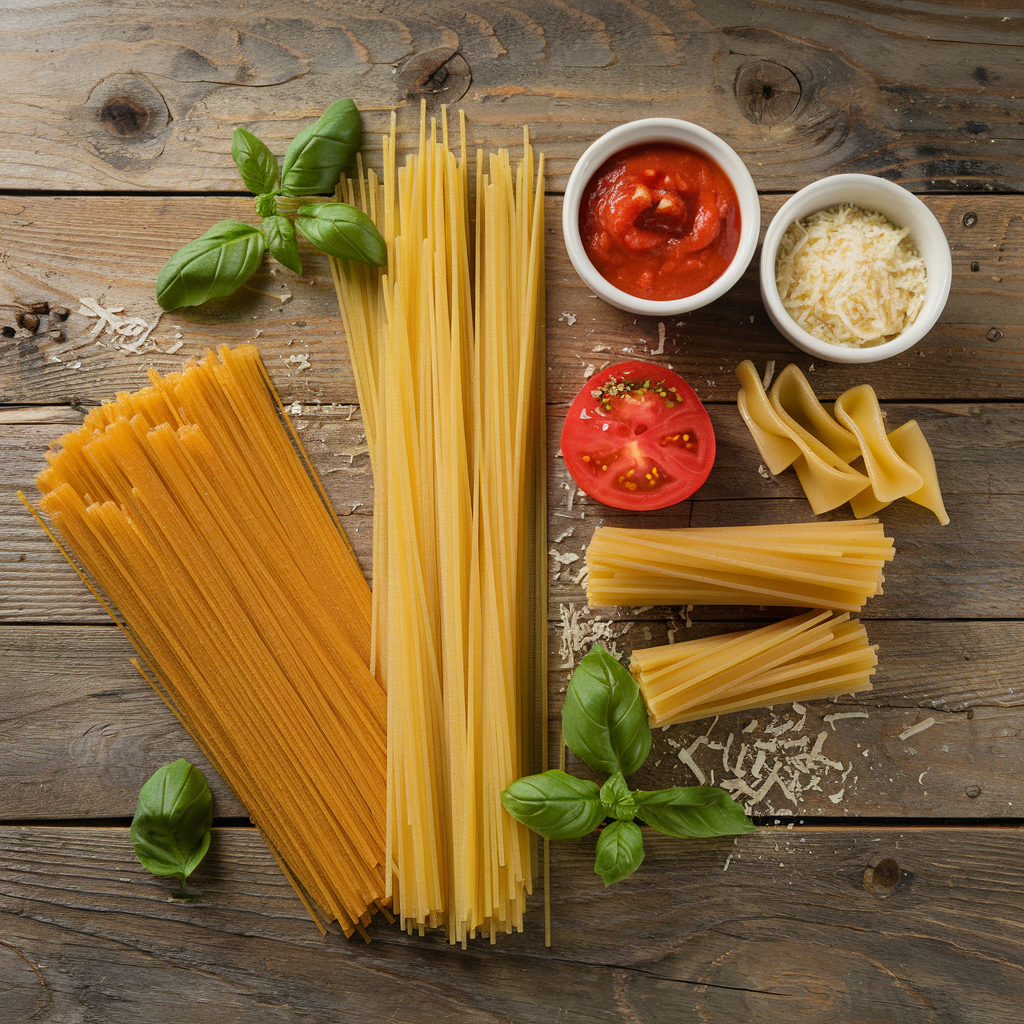Why You’ll Love This Recipe Guide
Understanding different pasta shapes isn’t just about expanding your culinary knowledge – it’s about matching the right pasta to the right sauce for the perfect Italian meal. Whether you’re making a quick weeknight dinner or planning a special occasion, knowing your pasta types will elevate your cooking game.
Pure Comfort
There’s something inherently comforting about a bowl of perfectly cooked pasta. Each shape carries sauce differently, creating unique eating experiences that have been perfected over generations of Italian cooking.
Ingredients
- Different types of durum wheat flour
- Semolina flour
- Water
- Eggs (for egg pasta)
- Salt
What You Need
- Pasta making machine (for homemade)
- Large pot
- Colander
- Measuring cups
- Kitchen scale
Time to Cook
- Fresh pasta: 2-4 minutes
- Dried pasta: 8-12 minutes
- Homemade pasta preparation: 45 minutes
Steps to Make It
- Long Pasta Shapes:
- Spaghetti: The classic round rod shape
- Linguine: Flattened spaghetti
- Fettuccine: Wider flat noodles
- Bucatini: Hollow spaghetti
- Short Pasta Shapes:
- Penne: Cylinder with angled ends
- Rigatoni: Wide tubes with ridges
- Fusilli: Spiral shape
- Farfalle: Bow-tie or butterfly shape
- Specialty Shapes:
- Orecchiette: Little ears
- Conchiglie: Seashells
- Rotelle: Wagon wheels
- Cavatappi: Corkscrew
Make It Perfect
The key to perfect pasta lies in the water ratio: use 1 liter of water per 100g of pasta. Always salt your water generously – it should taste like seawater.
Mix It Up
Try combining different pasta shapes with various sauces:
- Long, thin pasta with light, olive oil-based sauces
- Tubes and ridged pasta with chunky meat sauces
- Shell shapes with creamy sauces
- Twisted shapes with pesto
Perfect Partners
- Spaghetti: Perfect with tomato-based sauces
- Penne: Ideal for chunky vegetable sauces
- Fettuccine: Classic with alfredo sauce
- Orecchiette: Traditional with broccoli rabe
Busy Day Hero
Keep these quick-cooking shapes on hand:
- Angel hair pasta (cooks in 3-4 minutes)
- Small shells
- Orzo
- Quick-cook fettuccine
Work Ahead
Many pasta dishes can be prepared in advance:
- Cook pasta al dente and shock in ice water
- Store with a light coating of oil
- Reheat in boiling water for 30 seconds
Save Some For Later
Properly stored dried pasta lasts for:
- Dried pasta: 1-2 years
- Fresh pasta: 2-3 days refrigerated
- Cooked pasta: 3-5 days refrigerated
Everyone’s Happy
Pasta is incredibly versatile:
- Gluten-free options available
- Whole wheat varieties for health-conscious
- Colored pasta for fun presentations
- Mini shapes for kids
Good For You Too
- High in complex carbohydrates
- Good source of energy
- Can be enriched with vitamins
- Whole grain options available
Easy Clean Up
- Use a large enough pot to prevent boiling over
- Keep a wooden spoon across the pot to prevent overflow
- Rinse pasta tools immediately after use
- Store dried pasta in airtight containers
Switch It Up
Try these creative alternatives:
- Veggie noodles (zucchini, carrot)
- Bean-based pasta
- Ancient grain pasta
- Rice noodles
Simply Perfect
The best pasta dishes often have the fewest ingredients. Focus on:
- Quality pasta
- Fresh ingredients
- Proper cooking technique
- Balanced seasoning
FAQs
- Why does pasta come in so many shapes?
Different shapes hold sauces differently and provide varied textures. - Should I add oil to pasta water?
No, it prevents sauce from adhering to the pasta. - Why is al dente important?
It provides better texture and keeps pasta from becoming mushy. - Can I cook pasta ahead of time?
Yes, but it’s best served fresh. - How do I prevent pasta from sticking?
Use plenty of water and stir occasionally while cooking. - What’s the difference between fresh and dried pasta?
Fresh pasta is more tender and cooks faster but isn’t always better. - How do I know when pasta is done?
Test it by tasting – it should be firm but not hard.

For a deeper dive into long pasta dishes, explore Spaghetti Carbonara Recipes for authentic inspiration.
Short Pasta
These are perfect for holding chunky sauces or being baked into hearty dishes:
- Penne: Its ridges hold thick sauces beautifully.
- Rigatoni: Great for baked pasta dishes like Lasagna Bolognese.
- Fusilli: Spiraled pasta ideal for salads or creamy sauces.
For expert guidance, see Authentic Sicilian Pasta Recipes.
Pairing the right sauce with the right pasta is essential for a balanced dish. Learn more about this art through resources like Chicken Fettuccine Alfredo for creamy pairings or Hosting the Perfect Lasagna Dinner for baked dishes.
Conclusion
Understanding pasta types enhances your cooking repertoire and helps you create better-matched dishes. Whether you’re a novice cook or an experienced chef, having this knowledge allows you to make informed choices about which pasta to use for different recipes. Remember, the right pasta shape can transform a good dish into an exceptional
Dive deeper into the world of pasta, experiment with new recipes, and discover the joy of creating dishes that reflect your taste and creativity. Explore resources like Authentic Italian Food or learn How to Make Fresh Pasta to begin your pasta journey today.

